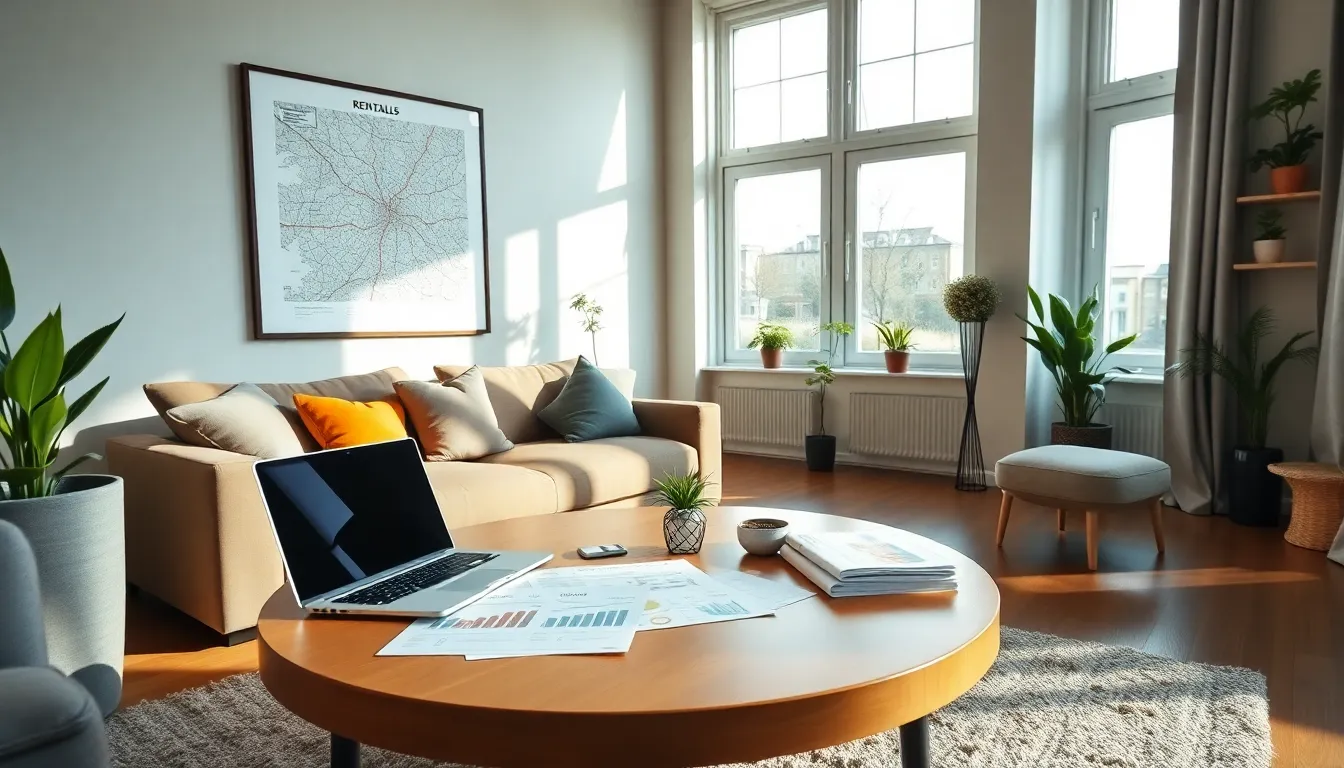Renting out a house can feel like spinning plates while riding a unicycle, one small hiccup, and everything could come crashing down. Yet, this intriguing realm of property rental isn’t just for the seasoned moguls. With the right insights, anyone can transform their house into a revenue-generating machine. This guide will take you through the essential steps, from understanding the rental market to ensuring your new tenants feel right at home. Ready to immerse? Let’s turn that property into a profit.
Table of Contents
ToggleUnderstanding The Rental Market

To successfully rent out a house, one must first comprehend the rental market dynamics. Knowing local demand helps to gauge how quickly properties are leased and influences the rental price.
Consider current trends by looking at rental statistics in your area. Are rentals flying off the market within days, or do homes linger for weeks? Are renters drawn to specific neighborhoods? By becoming well-versed in these trends, one can strategically position their property to attract potential tenants.
Also, keeping an eye on seasonal changes can provide invaluable insights. For instance, housing demand often rises in late spring and early summer. Understanding these patterns helps in planning when to put a property on the market or adjust pricing.
Evaluating Your Property For Rental
Before placing a house on the rental market, it’s crucial to conduct a thorough property evaluation. This involves examining the house’s condition and amenities to determine if any repairs or upgrades are necessary. After all, a well-maintained property is more likely to attract quality tenants.
Examine everything from plumbing to paintwork. Does the roof leak? Are appliances functioning? Walk through your home as if you were a potential renter. Pay attention to curb appeal, after all, first impressions matter.
Also, consider adding some attractive features that make the property stand out. A well-kept garden, modern kitchen appliances, or energy-efficient windows not only improve the rental value but also appeal to eco-conscious tenants.
Legal Considerations When Renting
Navigating the legal landscape is perhaps one of the most critical aspects when renting out a house. Before becoming a landlord, it’s essential to understand local rental regulations, which can vary from state to state.
First, familiarize yourself with landlord-tenant laws. What rights do tenants have? What are a landlord’s responsibilities? It’s beneficial to draft a detailed lease agreement outlining these aspects clearly. Include terms about security deposits, repairs, and termination conditions to avoid potential misunderstandings later.
Also, ensure compliance with safety and health regulations. Properties often require smoke detectors, carbon monoxide detectors, and possibly lead paint disclosures, especially in older homes.
Setting The Right Rent Price
Determining the right rent price strikes the perfect balance between attracting tenants and maximizing income. This involves research and a bit of market savvy.
Look at similar properties in the neighborhood, what are they charging? Tools like rental listings can provide clarity on competitive pricing. But, bear in mind factors unique to your property, such as its size, location, and amenities.
It’s advisable to avoid the temptation to overprice. A property sitting vacant costs money and effort. Likewise, unreasonably low rents can lead to being stuck with less desirable tenants. A well-researched, competitive price is key.
Marketing Your Rental Property
Once the price is set, it’s time to give the property a marketing boost. High-quality images truly speak a thousand words. Invest in professional photography to showcase your property in its best light.
Plus to online listings, consider traditional marketing methods. Flyers, local bulletin boards, or even teaming up with local real estate agents can widen reach. Social media platforms can be tremendous assets as well: sharing appealing posts about the rental can generate buzz.
Remember to highlight key features in descriptions that resonate with potential renters, like proximity to schools, public transport, or local parks.
Tenant Screening Process
The tenant screening process is a crucial step in ensuring that a property is rented to the right individuals. Start with applications: require potential tenants to fill out an application form to collect essential information.
Screen for rental history and references, but don’t stop there. Performing credit and background checks can provide insights into a tenant’s financial stability and reliability.
While it might be tempting to rush through this process, patience pays off. Having the right tenants reduces potential headaches further down the line. Look for responsible individuals who can maintain the property and pay rent promptly.
Managing Your Rental Property
Managing a rental property can feel like juggling multiple balls, but with a proper system in place, it can run smoothly. Stay organized by keeping thorough records of all transactions, maintenance requests, and communications with tenants.
Regular property inspections are necessary to ensure everything functions well and that guidelines are being followed. This proactive approach can prevent minor issues from becoming major headaches.
Also, establishing clear communication with tenants fosters a better landlord-tenant relationship. Responding promptly to maintenance requests or questions can go a long way in creating a positive living environment.
Preparing For Tenant Move-In
The days leading up to a tenant moving in are crucial. Ensuring the property is clean and ready goes a long way in making a great impression. Consider a professional cleaning service to make everything sparkle.
Before handing over the keys, schedule a walk-through with the tenants. This serves as an opportunity to explain rules and protocols while addressing any questions they might have. An understanding of procedures can help prevent future conflicts.
Finally, don’t forget the paperwork: ensure that all lease agreements are signed and documented. A smooth move-in sets a positive tone for the entire rental experience.







